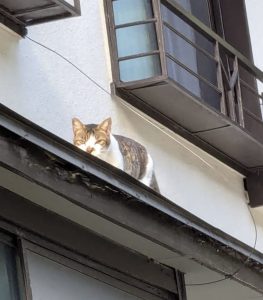色々と秘密の多い三毛猫でした(愛知県名古屋市千種区姫池通 骨董買取 古美術風光舎)
2024.09.29
皆さまこんにちは。スタッフHでございます。
昨夜は激しい雨と雷鳴で何度か目が覚めました。私以外の家族は熟睡していたようで信じられない思いです。
という訳で、少し眠気を抱えながら出勤しますと、いつもながらスヤスヤと穏やかに眠る「九谷焼の眠り猫」。こちらまで誘われてしまいそうで困ります。

実は本日9月29日は、9(来る)29(福)という語呂合わせで「招き猫の日」とされているようです。招き猫はもともと日本で多く見られる「三毛猫」がモデルとなっているとか。
愛猫家の方からお𠮟りを受けそうですが、私愚かにも今のいままで「三毛猫」という品種があるのだと思っておりました。実は猫の毛色が三種類、白、黒、茶色(オレンジに近い茶色)にはっきりと分かれている猫のことを総じて「三毛猫」というのですね。一般的には日本特有の猫とされており、血統猫よりも雑種猫で見かけることが多いとのこと。
昔から幸運を呼ぶ猫とされており、白は浄化、黒は厄除け、茶色は繁栄を意味し、三という数字も「満つ」と掛け合わせて、願いが満たされるとして縁起がよいとされています。昔の商家では商売繁盛を願い三毛猫を飼う習慣もあったようです。
縁起を担ぐだけでなく、三毛猫はその希少価値からも珍重されてきました。三毛猫は親が三毛猫であれば生まれるというものでもなく、またほとんどが雌として生まれてくるそうです。
通常は猫の毛色は色の濃淡はあっても一色から二色が多く、白黒茶の三色の猫が生まれる仕組みを知るには染色体との関係を知る必要があるとのこと。人も動物も性別を決める染色体は男性がXY、女性はXXで、ネコは元々白くなる遺伝子をもっており、白以外の黒と茶色の毛色を決める遺伝子は染色体のXにしかないそうです。そのためXを二つ持つ雌は白の他に黒と茶の三色になる可能性があり、X染色体を一つしか持たない雄は二色になる可能性が高いのです。
しかしごくまれに遺伝子の変異によりXXYの染色体を持つ雄が生まれるそうですが、その確率は1/30000とも言われており、かなり稀なことだそうです。その希少性から雄の三毛猫は幸運のシンボルとなり、江戸時代には多くの船で「航海の際に三毛猫の雄を飼っていれば安全が保障される」と信じられ一緒に船に乗り航海していたとか。実際に南極観測船の「宗谷」でも「たけし」と名づけられた三毛猫が乗っており船員たちに可愛がられたそうです。
他にも有名なところでは和歌山電鉄貴志川線の三毛猫駅長「たま駅長」がその愛らしさから人気を博したことを覚えています。利用者の減少から存続が危ぶまれた貴志川線に観光客を呼び込み、閉鎖寸前だった駅を救いました。正真正銘の「招き猫」ですね。
個人的にはこの「たま駅長」が私の三毛猫のイメージなのですが、三色の配色により様々な模様のパターンがあるようです。白が多く黒と茶色がしま模様になった「しま三毛」は物静かでおとなしい性格。白ベースに黒や茶色が所々に飛んでいる「とび三毛」は音や匂いに敏感。他にもコントラスが少なく柄がはっきりしていない「キジ三毛」やソフトな色合いでトーンが薄い色をしている「パステル三毛」などに分類されています。
現在の飼い猫の起源はエジプトのイエネコと言われています。ネズミをはじめとした害獣を駆除してくれる存在として農家などで飼われていました。突然変異や交配を繰り返しさまざまな毛色や柄の猫が生まれました。日本では古くから日本猫といわれる特有の猫の種類がおり、その1つである短い毛と丸い尻尾が特徴のジャパニーズボブテイルと呼ばれる品種に三毛猫が存在し、海外からの様々な種との交配で現在の三毛猫に至っているようです。
海外での人気も高く、英語では「キャリコ」、フランスでは「トリコロール」など洒落た名前で呼ばれているようです。北米やヨーロッパでは日本原産のジャパニーズボブテイルが「MIKE(みけ)」と呼ばれ愛されています。
私は猫を飼ったことがないので分かりませんが、三毛猫は雑種であることが多いため比較的丈夫で、猫らしさが溢れる知的で気まぐれな性格が魅力なのだそうです。プライドが高くマイペースでクールな一面と甘え上手な性格から「猫の中の猫」とも呼ばれるとか。
ここ覚王山で店主がよく出会うという猫ちゃんも三毛猫でしょうか?かなり警戒しているように見えますが…。
分かる方がいらっしゃれば教えてください。

それでは、また次の機会に。
Hello everyone. This is Staff H.
Last night I was awakened several times by heavy rain and thunderstorms. I couldn’t believe that everyone in my family except me seemed to be sound asleep.
So, I went to work feeling a little sleepy and found “Kutani Yaki Sleeping Cat” peacefully sleeping as usual. I am troubled by the fact that it seems to be luring me to sleep as well.
In fact, today, September 29, is “Manekineko Day,” which means “beckoning cat day” in Japanese because of the Japanese word “9” (come) and “29” (good fortune). The beckoning cat was originally modeled after the “tortoiseshell cat” that is often seen in Japan.
I am sure cat lovers will scold me for this, but until now I thought there was a breed of cat called “tortoiseshell cat”. In fact, the term “tortoiseshell cat” refers to cats with three distinct coat colors: white, black, and brown (almost orange). It is generally considered to be a cat unique to Japan, and is more often seen in mongrel cats than in pedigree cats.
They have long been considered lucky cats. White means purification, black means protection from bad luck, brown means prosperity, and the number “three” is also considered auspicious because it is crossed with “fullness,” meaning that your wishes will be fulfilled. In the old days, it was customary for merchants to keep tortoiseshell cats in the hope that their business would prosper.
Tortoiseshell cats have been prized not only for their good luck, but also for their rarity. Tortoiseshell cats are not necessarily born with tortoiseshell parents, and most are born as females.
Usually, cats have one or two hair colors, even if there are shades of color, and to understand how a black, white, and brown cat is born, it is necessary to understand the relationship between chromosomes. The chromosomes that determine the sex of both humans and animals are XY for males and XX for females. Cats originally have a gene that makes them white, and the gene that determines black and brown fur colors other than white is found only on chromosome X. Therefore, females with two X chromosomes are likely to have black and brown fur in addition to white, while males with only one X chromosome are more likely to have two colors.
However, in rare cases, a genetic mutation can produce a male with an XXY chromosome, but the probability is said to be as low as 1/30,000, which is quite rare. Because of its rarity, a male tortoiseshell cat became a symbol of good luck, and in the Edo period (1603-1867), many ships were believed to have kept a male tortoiseshell cat on board to guarantee their safety when they sailed. In fact, a tortoiseshell cat named Takeshi was on board the Antarctic research vessel Soya and was adored by the crew.
Another famous example is “Tama Ekicho,” the tortoiseshell cat stationmaster of Wakayama Electric Railway’s Kishigawa Line, who became popular for his adorable personality. He attracted tourists to the Kishigawa Line, which was in danger of being shut down due to a decline in the number of passengers, and saved the station, which was on the verge of closure. It is a true “beckoning cat.
Personally, this “Tama Ekicho” is my image of a tortoiseshell cat, but there seem to be various patterns depending on the color scheme of the three colors. The “Shima-Shimei,” which is mostly white with black and brown stripes, is quiet and gentle. The “Tobiti-Triplet,” which has a white base with black and brown flying in some places, is sensitive to sounds and smells. There are other categories such as the “Kiji Tortoiseshell,” which has little contrast and no distinct pattern, and the “Pastel Tortoiseshell,” which has soft colors and light tones.
The origin of today’s domestic cats is said to be the Egyptian Aedes aegypti. They were kept by farmers and others as a means of exterminating rats and other vermin. Through repeated mutations and crossbreeding, cats of various coat colors and patterns were born. In Japan, there has long been a unique breed of cat called the Japanese Bobtail, which is characterized by short hair and a round tail.
The tortoiseshell cat is very popular overseas, and is called by fashionable names such as “calico” in English and “tricolor” in France. In North America and Europe, the Japanese Bobtail, which is native to Japan, is called “MIKE” and is well-loved.
I have never owned a cat, so I don’t know, but I hear that tortoiseshell cats are often hybrids, so they are relatively hardy and have an intelligent and whimsical personality that is full of cat-like qualities. They are also called “cats among cats” because of their pride, their own pace, their cool side, and their sweet nature.
Is the cat that the owner often encounters here in Kakuozan also a tortoiseshell cat? It seems to be very wary of her.
Please let me know if you know.
See you next time.
*******************
ご実家の整理やお片付けなどをされている方のご相談などが多くございます。
お片付けなどくれぐれもご無理のないようになさってくださいませ。
風光舎では古美術品や骨董品の他にも絵画や宝石、趣味のお品など様々なジャンルのものを買受しております。
お片付けをされていて、こういうものでもいいのかしらと迷われているものでも、どうぞお気軽にご相談下さいませ。
また風光舎は、出張買取も強化しております。ご近所はもちろん、愛知県内、岐阜県、三重県その他の県へも出張いたします。
まずは、お電話お待ちしております。
愛知県名古屋市千種区姫池通
骨董 買取【古美術 風光舎 名古屋店】
TEL052(734)8444
10:00-18:00 OPEN

